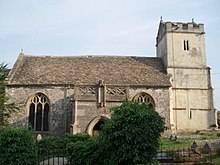|
St James' Church, Charfield
St James' Church is a historic Anglican church at Churchend in the village of Charfield, Gloucestershire, England and is under the care of The Churches Conservation Trust.[1] It is recorded in the National Heritage List for England as a designated Grade I listed building.[2] It stands on a steep hillside overlooking a valley.[1] HistoryThe church originates from the 13th century.[2] It was largely rebuilt in the 15th century, using money from the local wool trade. During the 18th century the industry moved into the valley, isolating the church.[1] It was repaired during the 1970s.[2] ArchitectureSt James' is constructed in stone rubble, with Cotswold stone slate roofs. Its plan consists of a nave with a south aisle and a north porch, a chancel, and a west tower. The tower is in four stages with diagonal buttresses. In the top stage are two-light bell openings, and the parapet is battlemented.[2] On top of the tower is a saddleback roof.[1] In the north wall of the nave are two three-light windows, between which is a porch with a pierced parapet and a niche for a statue. The chancel contains two three-light windows in the north wall, a three-light east window, and a blocked priest's door. Along the wall of the south aisle are three three-light windows.[2] Internally, between the nave and the south aisle is a three-bay arcade with octagonal piers. In the nave is a squint. The chancel contains a trefoil-headed piscina and the remains of heads to image niches. There are memorials dated 1717 and 1756.[2] External featuresThe churchyard contains five separate chest tombs, and a group of four chest tombs, all of which are designated as Grade II listed buildings. They all date from the 18th century and are in limestone ashlar.[3][4][5][6][7] The group of four tombs date from the same period and are surrounded by cast iron railings.[8] Also in the churchyard is a memorial to the 15 people who were killed in the Charfield railway disaster in 1928,[9] and the war grave of a World War II airman.[10] See alsoReferences
|
||||||||||||||||||||||||||||||||||||||

